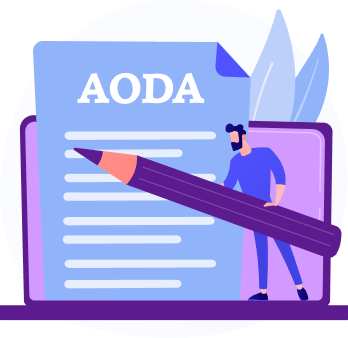Navigating AODA Website Compliance: Ensuring Accessibility for All
In an increasingly digital world, the accessibility of websites is paramount to ensuring that everyone, including individuals with disabilities, can fully participate in the digital sphere. Ontario's Accessibility for Ontarians with Disabilities Act (AODA) recognizes this and includes specific standards for web accessibility. AODA website compliance is a critical aspect of fulfilling the province's goal of making Ontario fully accessible by 2025. In this article, we'll delve into the importance of AODA website compliance and explore key components to make websites more accessible.

The Significance of AODA Website Compliance
AODA website compliance is more than just a legal requirement; it's a commitment to inclusivity, diversity, and equal access. Ensuring that websites are accessible is essential because it empowers individuals with disabilities to:
1. Access Information: Accessible websites ensure that individuals with disabilities can access information, news, and services independently.
2. Engage with Businesses: An accessible website allows people with disabilities to engage with businesses, complete transactions, and access products or services.
3. Participate in Society: By making online content accessible, websites ensure that individuals with disabilities can participate more fully in education, employment, and social activities.
Key Components of AODA Website Compliance
To ensure your website is in compliance with AODA, you should address several crucial components:
1. Web Content Accessibility Guidelines (WCAG):
The Web Content Accessibility Guidelines, or WCAG, serve as the international standard for web accessibility. AODA references WCAG 2.0 Level AA and WCAG 2.1 Level AA for compliance. To align with AODA, websites should adhere to these guidelines to make content perceivable, operable, and understandable for everyone.
2. Text Alternatives:
Images, videos, and non-text content should have descriptive text alternatives. This allows screen readers and other assistive technologies to convey content to individuals with disabilities.
3. Keyboard Accessibility:
Websites should be navigable and functional using only a keyboard, as some individuals with disabilities may not use a mouse.
4. Consistent Navigation and Structure:
Maintain a consistent and logical structure throughout the website to help users easily understand and navigate content. Proper headings, labels, and semantic HTML contribute to a more accessible website.
5. Captions and Transcripts:
For multimedia content, including videos and audio, provide captions, transcripts, and audio descriptions to ensure accessibility for individuals with hearing or visual impairments.
6. Contrast and Text Size:
Ensure adequate contrast between text and background colors to make content readable. Additionally, allow users to resize text without loss of functionality or content.
7. Forms and Input Fields:
Forms on your website should be designed for accessibility. This includes proper labeling and error notifications to assist users in completing forms.
8. User Testing:
Regularly test your website with users who have disabilities. Their feedback can identify areas that need improvement, ensuring a more accessible user experience.
9. Accessibility Statements:
Include an accessibility statement on your website, which informs users about the level of compliance and provides contact information for accessibility inquiries or issues.
10. Compliance Reporting:
Maintain records of your website's accessibility efforts and, if applicable, the resolution of any reported issues. These records can demonstrate your commitment to AODA compliance.
The Benefits of AODA Website Compliance
AODA website compliance goes beyond legal obligations. It offers numerous benefits, including:
1. Expanding Your Audience: An accessible website ensures that individuals with disabilities can engage with your content, products, or services, expanding your reach and customer base.
2. Positive Public Image: Commitment to accessibility fosters a positive public image, showing that your organization values diversity and inclusivity.
3. Legal Protection: Compliance reduces the risk of legal issues related to accessibility, which can be costly and damaging to reputation.
4. Enhanced User Experience: Accessibility features often enhance the user experience for everyone, leading to increased user satisfaction and engagement.
In conclusion, AODA website compliance is a fundamental step toward creating an inclusive, diverse, and accessible digital environment in Ontario. It's not merely a legal requirement; it's a moral and social responsibility that benefits everyone. By following the key components outlined in this article, organizations can make their websites more accessible, helping Ontario progress toward a more inclusive future for all residents, regardless of their abilities.
By using this site you agree to this Privacy Policy. Learn how to clear cookies here
शेयर मार्केट: अमीर बनने का रास्ता या पैसा गंवाने का जुआ? صلاة التهجد: رحلة روحية في ظلمة الليل John Lennon: Legendarny Muzyk, Ikona Pokoju No Other Land James Brown: He's Got the Funk and the Fury James Brown: The Legendary Godfather of Soul Is Softcover the Same as Paperback Airdrie Insulation Services Well Taken Care Of - Health, Personal Training & Functional Nutrition Coaching